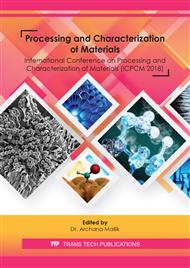p.250
p.257
p.264
p.271
p.277
p.284
p.291
p.296
p.304
Thermal Shock Effect of Nano-TiO2 Enhanced Glass Fiber Reinforced Polymeric Composites: An Assessment on Tensile and Thermal Behavior
Abstract:
Fiber reinforced polymeric (FRP) composite materials are currently used in numerous structural and materials related applications. But, during their in-service period these composites were exposed to different changing environmental conditions. Present investigation is planned to explore the effect of thermal shock exposure on the mechanical properties of nanoTiO2 enhanced glass fiber reinforced polymeric (GFRP) composites. The samples were conditioned at +70°C temperature for 36 h followed by further conditioning at – 60°C temperature for the similar interval of time. In order to estimate the thermal shock influence on the mechanical properties, tensile tests of the conditioned samples were carried out at 1 mm/min loading rate. The polymer phase i.e. epoxy was modified with different nanoTiO2 content (i.e. 0.1, 0.3 and 0.5 wt. %). The tensile strength of 0.1 wt.% nanoTiO2 GFRP filled composites exhibited higher ultimate tensile strength (UTS) among all other composites. The possible reason may be attributed to the good dispersion of nanoparticles in polymer matrix corresponds to proper stress transfer during thermal shock conditioning. In order to access the variations in the viscoelastic behavior and glass transition temperature due to the addition of nanoTiO2 in GFRP composite and also due to the thermal shock conditioning, dynamic mechanical thermal analysis (DMTA) measurements were carried out. Different modes of failures and strengthening morphology in the composites were analyzed under scanning electron microscope (SEM).
Info:
Periodical:
Pages:
277-283
Citation:
Online since:
February 2020
Price:
Сopyright:
© 2020 Trans Tech Publications Ltd. All Rights Reserved
Share:
Citation:


